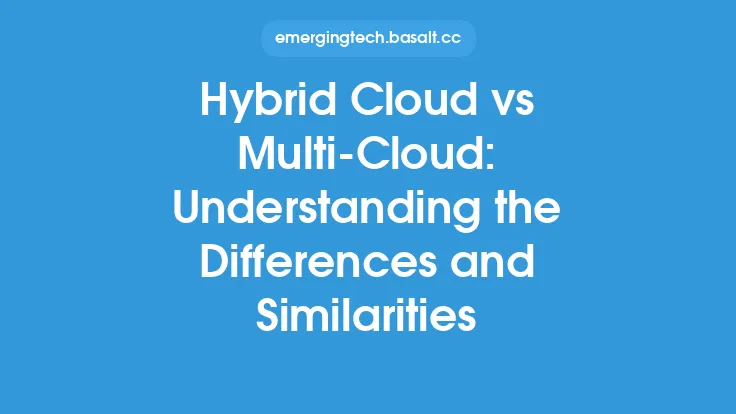The advent of cloud computing has revolutionized the way businesses operate, providing them with unprecedented flexibility, scalability, and cost-effectiveness. Among the various cloud deployment models, hybrid cloud has emerged as a popular choice, offering a unique blend of public and private cloud infrastructure. This approach allows organizations to leverage the benefits of both worlds, creating a highly adaptable and efficient IT environment. In this article, we will delve into the benefits of hybrid cloud, exploring its flexibility, scalability, and cost-effectiveness in detail.
Introduction to Hybrid Cloud Benefits
Hybrid cloud offers a range of benefits that make it an attractive option for businesses of all sizes. By combining public and private cloud infrastructure, organizations can create a tailored IT environment that meets their specific needs. One of the primary advantages of hybrid cloud is its ability to provide flexibility, allowing businesses to quickly respond to changing market conditions and customer demands. With hybrid cloud, organizations can easily scale up or down, depending on their requirements, without being locked into a specific infrastructure.
Flexibility in Hybrid Cloud
The flexibility of hybrid cloud is rooted in its ability to integrate public and private cloud infrastructure seamlessly. This allows organizations to move workloads between different environments, depending on their requirements. For instance, an organization can use a public cloud for web-based applications, while keeping sensitive data and mission-critical workloads on a private cloud. This flexibility also extends to the choice of cloud providers, as organizations can select the best-of-breed services from multiple vendors. Furthermore, hybrid cloud enables businesses to adopt a cloud-first approach, where new applications and services are deployed on the cloud, while legacy systems are maintained on-premises.
Scalability in Hybrid Cloud
Scalability is another significant benefit of hybrid cloud, as it allows organizations to quickly scale up or down to meet changing demands. With hybrid cloud, businesses can take advantage of the scalability of public cloud infrastructure, while also leveraging the control and security of private cloud. This scalability is particularly useful for organizations that experience fluctuating workloads, such as e-commerce companies during peak shopping seasons. By scaling up or down, businesses can ensure that their IT infrastructure is always optimized, reducing waste and improving resource utilization. Additionally, hybrid cloud enables organizations to scale out, by adding new resources and services as needed, without being limited by the constraints of on-premises infrastructure.
Cost-Effectiveness in Hybrid Cloud
Hybrid cloud is also highly cost-effective, as it allows organizations to optimize their IT spending. By leveraging public cloud infrastructure for non-mission-critical workloads, businesses can reduce their capital expenditures and operational expenses. At the same time, hybrid cloud enables organizations to maintain control and security over sensitive data and mission-critical workloads, which are typically kept on private cloud infrastructure. This approach also enables businesses to avoid vendor lock-in, as they can choose the best-of-breed services from multiple vendors. Furthermore, hybrid cloud allows organizations to take advantage of the cost savings associated with cloud computing, such as reduced energy consumption, lower maintenance costs, and improved resource utilization.
Technical Benefits of Hybrid Cloud
From a technical perspective, hybrid cloud offers several benefits, including improved security, enhanced performance, and increased reliability. By integrating public and private cloud infrastructure, organizations can create a highly secure IT environment, with multiple layers of protection and redundancy. Hybrid cloud also enables businesses to take advantage of advanced technologies, such as artificial intelligence, machine learning, and the Internet of Things (IoT). Additionally, hybrid cloud provides improved performance, as organizations can optimize their IT infrastructure for specific workloads and applications. This is particularly useful for organizations that require low latency and high throughput, such as financial institutions and healthcare providers.
Real-World Applications of Hybrid Cloud
Hybrid cloud has a wide range of real-world applications, across various industries and sectors. For instance, a financial institution can use hybrid cloud to deploy a mobile banking application, while keeping sensitive customer data on a private cloud. Similarly, a healthcare provider can use hybrid cloud to deploy a telemedicine platform, while maintaining patient records on a private cloud. Hybrid cloud is also useful for organizations that require disaster recovery and business continuity, as it provides a highly resilient and redundant IT infrastructure. Additionally, hybrid cloud enables businesses to take advantage of cloud-based services, such as software-as-a-service (SaaS), platform-as-a-service (PaaS), and infrastructure-as-a-service (IaaS).
Conclusion
In conclusion, hybrid cloud offers a range of benefits, including flexibility, scalability, and cost-effectiveness. By integrating public and private cloud infrastructure, organizations can create a highly adaptable and efficient IT environment, tailored to their specific needs. Hybrid cloud also provides technical benefits, such as improved security, enhanced performance, and increased reliability. With its wide range of real-world applications, hybrid cloud is an attractive option for businesses of all sizes, across various industries and sectors. As the cloud computing landscape continues to evolve, hybrid cloud is likely to play an increasingly important role, enabling organizations to innovate, disrupt, and thrive in a rapidly changing world.





